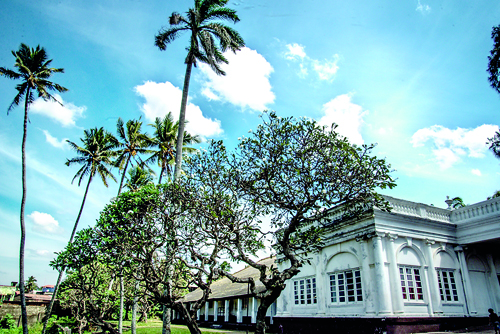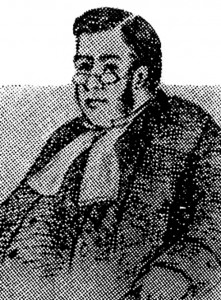Debbie’s Whist quest
Deborah Philip and I are discussing energy drinks. In particular, the one that kept her awake till 3 a.m. preparing for her Colomboscope presentation on the Grand Oriental Hotel. Debbie had two sessions scheduled (the second being on another festival venue – the Whist Bungalow), so you could sympathise with her attack of nerves, particularly when you consider this young history graduate was engaged in primary research.
To tell the story of these wonderful old buildings and their inhabitants over decades, she combed through books, websites and old photographs; spoke with the families of one-time owners and corralled desk clerks, hotel managers and several history enthusiasts and collectors who knew something of the period. She also did plenty of exploring and with the help of friendly people in the

Landmark building: Whist bungalow. Pic by Ruvin de SIlva, courtesy Colomboscope
neighbourhood located the Antony family who were the last individual owners of Whist. In the end, she pulled together a presentation as unconventional as she is – unaffected, warm and quirky, it introduced us to the buildings through the lives of the men she dubbed her ‘protagonists’, giving us a glimpse of another, older Sri Lanka.
Whist Bungalow’s stunning location on a small knoll overlooking a long curve of beach is impossibly romantic, but the local community finds all sorts of uses for it – from shoe sales to weddings.When Debbie looks at the building’s previous owners with a historian’s eye, she sees individuals that quite often didn’t fit in – in particular the Eurasians or Burghers who qualified as both coloniser and colonised. “You see them making significant contributions to the political landscape of the 19th century,” she explains, adding that when looked at in the context of Colomboscope’s theme of ‘Making History,’ these also became “the people whose voices had been silenced in the dominant narrative of Sri Lanka.”
In compiling her research on Whist, Debbie began with 20th Century Impressions of Ceylon (1907). Who built Whist remains a bit of a mystery but there’s some speculation that it may have been Henry Augustus Marshall – the first Auditor General of Ceylon. The first

Tracing the past: Deborah Philip. Pic by Malaka Pathmalal
proper account of the building appears in James Cordiner’s ‘A Description of Ceylon’ and dates back to 1807. It allowed Debbie to estimate that the bungalow was built somewhere between 1797 and 1804. According to Cordiner, the membership of the exclusive ‘Whist-club’ consisted of 12 men who would give ‘dinners in rotation and generally invite 12 strangers.’ A games of cards usually ensued.
As part of her presentation, she declared up front, “You’re going to find I’m obsessed with certain people at Whist.” In this case, she meant Richard Morgan – the first Eurasian to be made a District Judge of Colombo and later, Acting Chief Justice of the Supreme Court. When Debbie has a soft spot for someone, she dedicates a pyramid to them, listing significant milestones in their lives from base to tapering point. (Morgan’s includes a bright red arrow that shows his progression from radical to conservative.)Morgan was an influential man and it’s easy to imagine when you look at Whist’s imposing entrance, that the neighbourhood of Mutwal it’s nestled in was once the abode only of the rich.
Less than three miles north of Fort, the area underwent a dramatic transformation when the harbour was built. (“Steamships were coming in and the soot from them began polluting these affluent neighbourhoods, forcing people to move further south, to Cinnamon Gardens,” says Debbie.)
However, you haven’t got all that much further into Debbie’s presentation before you realise she has bigger ambitions.She wants to place Whist in the context of its neighbours, in particular Elie House, which would at one point become the home of Charles Ambrose Lorenz, Morgan’s friend and contemporary. (Debbie has pictures of the curious, circular structures that are all that remain of Elie House today.)
Our guide only allows herself to be so distracted because her affections are tied between Lorenz and Morgan. (Lorenz too has his pyramid.) “What I like about him is that he was possibly the founder of Ceylonese journalism because he bought the Examiner paper

Richard Morgan
with his friends in 1852,” she says. Unlike Morgan, Lorenz also remained a radical to the end, even leading the famous 1864 walkout of the unofficial members from the Legislative Council. And while they were still idealists, the two men were involved in the 1848 rebellion and remained engaged with the politics of their time.
Revealingly, Morgan’s wife receives barely any mention and Lorenz’s – who had by all accounts quite an intellect – gets only a chapter in his biography. (Debbie says that she would have liked to see women more widely represented in the records but that simply wasn’t the case.) Despite this and other such instances where she was either unable to uncover further information or verify what references she did find, her presentation is an engaging one, filled with anecdotes of political history being made, family heirlooms lost and interesting connections established; bandicoots ‘haunting’ Whist meet a grisly end, elegant parties bring society thronging to lavish affairs, ‘natives’ appear to protest in its vicinity and through it all the house maintains its impassive face.
This is not her first foray into public speaking: Debbie has previously discussed her family’s informal archive – her grandfather, the artist and architect W.J.G. Beling, was a member of the ’43 Group who left behind a fascinating collection of photographs and letters (including one from the Nobel Prize winning poet Pablo Neruda, dating back to his time in Sri Lanka.) Currently, Debbie works for her church but all this study has ignited an interest in travelogues and she hopes to pursue more research along those lines.
In particular, she’d like to find ways to make obvious history’s relevance to modern Sri Lanka and the lessons it holds for a multi-cultural society such as ours. Though it may surprise you, it’s revealing that while these are made manifest in her own ancestry, her colourful, complicated heritage isn’t her focus –instead she has her eyes trained to the bigger picture.



